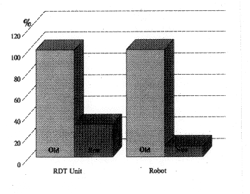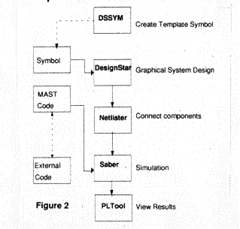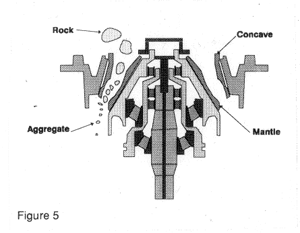|
Department of Mechanical Engineering, University of Technology Loughborough, Leicestershire, UK.
Telephone: +44 (0)1509 22 3747
Department Of Mechanical Engineering, University of Technology Loughborough, Leicestershire, LE11 3TU
Abstract
Conventional combinational design philosophies are, in many cases, proving inadequate for the sophisticated products and speed of response demanded by today's markets. The consideration of a fourth, or temporal, dimension in product design may, in many circumstances, exacerbate the problems placed in the designers path. Evolution in the way that products are viewed and advances in miniaturisation are providing opportunities to break the, largely causal, link between form and function. Whilst this may provide exciting new designs, it also creates conceptual problems for the designer.
Mechatronic design philosophies and concurrent practices for achieving the physical embodiment of the designers creative output are seen as an appropriate response to the challenge. Mechatronics is a holistic design philosophy which can yield intelligent machines (e.g. self driving vehicles, robotic surgeons) for the benefit of mankind. The rapid evolution of new techniques involving modelling environments, virtual reality, artificial intelligence, rapid prototyping, etc. gives great help to the designer but at the same time places large demands on his time.
There are few tools to assist the mechatronic designer due to the complex nature of the interactions between mechanical, electronic and computer systems. This is compounded by the elastic nature of the temporal dimension which requires, at one end of the scale, real time control systems and adaptive learning systems at the other. This paper discusses some of the issues and describes the benefits of an integrated approach towards product design.
Introduction
Changes in the way products are designed and constructed have largely come about due to advances in technology. The growth of electronics has meant that intelligence may be embedded in a product providing a lower cost solution with enhanced flexibility and hence an increased level of customer perceived value. Such rapid growth in affordability has resulted in the replacement of many previously mechanical functions by electronic or computer functionality[1]. More recent trends have focused on ever smaller mechanical components, fuelled by the production processes necessary for semiconductor devices. This trend towards micro-mechanics opens up yet further horizons.
Mechatronics may be described as an integrative discipline utilising the technologies of Mechanics, Electronics and IT to provide enhanced products, processes and systems. As examples of what mechatronics can provide, in terms of advanced products, one may consider a wide range of applications. In the field of consumer products the exemplars are items such as the modern 35mm camera, the CD player and the Camcorder. Some of the latest camcorders have built in solid state gyroscopes that permit the image to be adjusted to give jitter free recording, paving the way for images recorded from moving platforms (e.g., cars) to give acceptable reproduction.
In the commercial field we need look no further than the ubiquitous Automated Teller Machine (ATM) or hole in the wall [2]. The bank of the future has few, if any, people servicing it. Fourth Generation ATMs have full capability multi-media display systems that can interact with the customer.
In the industrial sector there are many examples, Surface Finish and Roundness Instruments, Coordinate Measuring Machines, etc. There are even examples in the Architectural and Shipbuilding Industries. The automotive industry has many examples; ABS, traction control and intelligent suspension are now widely accepted. Research is being conducted on navigational
systems using satellite and radar with a significant leading role being taken by Toyota[3].
Conventional design philosophies and organisations leave much to be desired. In many cases the Mechanical and the Electronic Design departments of companies may even be in different cities or even countries. If, perchance, they are in the same building then they do not tend to communicate with each other with a concomitant effect on product design. Often the Mechanical Engineers design a machine; when finished they hand it on to the Electrical/Electronic engineers to design and fit the control systems and they hand it on to the software engineers to write the control programmes. Mechatronics is a trans disciplinary approach, based on open communication systems and concurrent practices, to design better engineering products. There have been many attempts to provide tools to aid the mechatronic designer [4] and whilst there have been some failures, there is some progress in holistic approaches[5]
Cost Benefits
The cost benefits of the mechatronic approach may be demonstrated by two examples, arising from industrially funded programmes of work, which have been fully reported elsewhere [6].
These programmes of work resulted in products which had a significant cost advantage over their previous counterpart systems (Figure 1). The woodworking example reduced the works cost to 30% of its previous value and the robot example reduced the works cost to a staggering 10% of its previous figure.

(Click to enlarge then BACK to return) The work on CIM for the woodworking industry has been extended to the machinery used to produce the complex cutter blocks. Use is made of the files produced in the CAD system when designing the timber sections. Hewlett Packard Graphics Language (HPGL) is used as the generic transfer medium. The machine controller mimics a plotter and interpolates the data before transferring it to the six axis controllers of the cutter grinding machine. The machine makes use of embedded control and AI techniques [7].
Design Approach
As previously stated, the approach is holistic and often relies heavily on heuristic knowledge and the skill of the designer. It is becoming increasingly difficult to ensure good control over the design process when there are many people having input. A recent presentation[8] detailed the problems involved in a major project concerning print and photocopy machinery having a team of over 500 engineers and designers with a duration of six years.
Computer assisted design tools have been available for some time (CAD, ECAD & CAM) to help with the more mechanistic aspects of product design and manufacture. More recent trends have been to provide assistance with design constraints and physical performance (eg, CFD, FEA). There have also been systems that have helped to evaluate performance but they have been restricted to control systems, analogue or digital electronics (in the form of circuitry or IC designs) in the main. More recently there has been a welcome move towards multi-technology simulators that are proving invaluable to the Mechatronic design fraternity. One such package is Saber which can integrate mechanics, electronics and even computer control code and allow a designer to do his what if analyses as well as evaluate the effect of component tolerancing, ageing, thermal cycling, etc. The sequence of events for the design and analysis process is shown in figure 2. The drawback to widespread usage of such packages is that they are expensive and, due to their size and complexity, only operate on sophisticated workstations in a UNIX environment.

(Click to enlarge then BACK to return) The benefits of such design approaches are manifold and transcend normal disciplinary boundaries. A good example of this is provided by a project involving the scalloping of lace using a complex mechatronic machine incorporating machine vision to identify and track lace patterns with laser cutting for high speed and lack of wear[9]. Lingerie designers previously had to avoid getting the lace on the skin line as this could cause customer discomfort. The new cutting method provides a significant comfort enhancement allowing the lingerie designers new freedom. It is also more versatile than knife cutting and so the lace designers have greater freedom and complex designs can now be cut economically.
Future Trends
The future has much to offer. The reduction in component sizes is providing new types of actuator and sensors which are being increasingly utilised in complex systems such as the provision of low cost radar sensors (figure 3) for autonomous robot systems and automotive uses[10]

(Click to enlarge then BACK to return) A recent programme funded by the DTI and EPSRC under the LINK High Speed Machinery Initiative [11] involves the collaboration of industry with two universities. It concerns the high speed handling of flexible packages (eg, crisps, peanuts, blood bags, wrapped shirts). They are flown on a bed of air and steered by arrays of advanced pneumatic actuators (figure 4). The actuators are of a novel design and make use of piezo materials for ultra high speed switching.

(Click to enlarge then BACK to return) Many of the advances are being fuelled by the rapid growth in integration of sensors and systems in silicon. Microcontrollers (special purpose computers dedicated to embedded control tasks) are becoming more sophisticated with many input/output functions. Current devices have typically 84 pins with significant on board amounts of RAM and ROM memory permitting many applications to be run with only one IC and very little support hardware. Laboratory scale devices already have around 250 pins and 500 pins are predicted for availability within the next five years. Future engineering products are likely to be controlled by massively parallel microcontroller architectures [12]Artificial Intelligence techniques are developing with applications of Knowledge Based Systems (utilising the heuristic pool of knowledge from human experts) being reported in many areas. A typical programme involves the intelligent cone crusher. Cone crushers are very large items of equipment that break up rock for the mineral extraction and quarrying industries. Their major output is that of stone chippings for roadmaking. In the UK they consume 6.25 TW hrs per year, which is some 3% of total installed generating capacity. They produce 100T of roadstone per hour which sells at [sterling]7.50 per Tonne. Wear of the crushing components takes place at 1mm per hour which means a strip down for replacement once per fortnight with a parts cost of [sterling]3k in addition to lost revenue on sales amounting to a total of some [sterling]10k.
The design of the overall system is very complex[13] and needs to be capable of taking account of differences in individual quarry plant configurations and future growth of sub-systems and features. This has been achieved via the inclusion of devolved intelligence in the form of distributed processing (Figure 5). The system is arranged such that the master controller elicits information on the sub-systems that are present at start up time. This facilitates the addition of other components (eg a product sizing and grading instrument) at a later date[14].
More advanced control techniques are permitting a more human like activity of machines[15]. Aspects of Artificial Intelligence, based on biologically inspired systems, are providing on a micro level (in the form of neural networks[16]) and a macro scale (in the form of behavioural robotics and autonomous devices). Advances are such that the EU Panorama programme has demonstrated autonomous navigation in the Finnish tundra [17] and the Americans have a vehicle that travels along the freeway at speeds up to 15 mph without a driver.

(Click to enlarge then BACK to return)
The complexity of modern products and processes are bringing new challenges to the design community. Products processes and systems designed with a mechatronic approach yield a significant advantage in functionality, price or both.
The practice of mechatronics is not confined to any one field but has a breadth of application ranging from precision metrology to quarrying machinery; from surgical instruments to buildings. Design tools are becoming available to aid the conceptual, partitioning and optimisation aspects of the design process.
Mechatronics is an intellectually challenging philosophy requiring engineers of vision, co-operating with specialists from other fields, to produce advanced intelligent products. The fusion of pragmatically oriented engineering approaches with the conceptual and art oriented disciplines provides an integrated platform from which to seek the products of the future.
References
1) Mechatronic Systems for Industrial Use. P Drews, W Trier. Int Journal of Intelligent Mechatronics Design & Production. Vol 1 No 1, Sept 1994.
2) Self-service Banking and Mechatronics: The First twenty Years . J Dinsdale, A J Hutcheon Proceedings I MechE Int Conf. Mechatronics: Designing Intelligent Machines, 12-13 Sept 1990, ISBN 0 85298 722, pp149-158.
3) Annual Report 1995 Toyota. Toyota Motor Corporation, 1, Toyota-Cho, Toyota City, Aichi Prefecture 471, Japan.
4) A Comparative Study of System Simulation Techniques in MechatronicsX T Yan, J E E Sharpe Proceedings IEE, Control 94, Vol 2 ISBN 0 85296 611 3, pp 1225-1228, 21-24 March 1994, University of Warwick. pp 934-940 .
5) Customer Needs, Function Structures and Strategic Development of a Mechatronic Product. A Verho, V Salminen Int Conf on Recent Advances in Mechatronics, ICRAM ë95, Aug 14-16 1995, Istanbul, Turkey.
6) The Application of SMART Cards for Quality Assurance via Effective Data Management MR M Parkin, B S Dalay, I Ferry CETIM, ISBN 2-85400-236-9. Proceedings COMADEM 92, 4th International Congress and Exhibition. Centre Technique Des Industries Mechaniques, Senlis, France, July 15 - 17 1992. p 505- 510.
7) Unsupervised Learning for KBS in the Control of Grinding Machinery B S Dalay, R M Parkin Proceedings, Int. Workshop on Mechatronical Computer Systems for Perception and Action, 1-3 June 1993, Halmstad University, Sweden. ISBN 91-630-1847-0 p97-104
8) Xero Mechatronics J Elter (Xerox Corporation) Mechatronics Forum Prestige Lecture, IEE, Savoy Place, London, 24 April1995.
9) High Speed Laser Cutting of Lace. M R Jackson, Me Preston, S Yang, L G Tao, T G King. European Symposium on Optics for Productivity in Manufacture, 20-24 Jun 1994, Frankfurt, Germany
10) A Development platform for Low Cost FM-CW Radar Sensors, B Tao, R M Parkin, M R Jackson. Recent Advances in Mechatronics, Eds Kaynak, Ozkan, Bekiroglu, Tunay; Proc Int Conf on Recent Advances in Mechatronics, ICRAM ë95, 14-16 August 1995, Istanbul, Turkey. Vol 1 ISBN 975-518- 063-X, pp418-423.
11) Soft Product Assembly & Manipulation C Turner, A Davies, R Parkin, J Knight Proceedings, Intelligent Automation for Processing Non-Rigid Products, IEE Colloquium, 19 Oct 1994, London. Digest No 1994/191, ISSN 0963-3308,
12) Distributed Control of Mechanical Systems. M Torngren Licentiate Thesis, Royal Institute of Technology (KTH) Stockholm,Sweden. ISSN 0282 0048, 1992
13) The Application of KBS For Real Time Control of Cone Crushers. M Moshgbar, R Parkin, R Bearman. Proceedings IEE Systems Engineering for Real Time Applications, 13-15 September 1993, Royal Agricultural College, Cirencester. ISBN 0 85296 593 1. ISSN 0537 9989. p172-177
14) Roadstone Aggregates: An Intelligent Opto-mechatronic Product Classifier for Sizing &Grading. R M Parkin, D W Calkin, M R Jackson. Mechatronics, Pergamon. Vol 5, No1, 0957-4158/9, 7pp.
15) Brain Simulation and Autonomous Robots. M A Arbib, G Bekey, T Lewis Proceedings, Int. Workshop on Mechatronical Computer Systems for Perception and Action, 1-3 June 1993, Halmstad University, Sweden. ISBN 91-630-1847-0 p1-10
16) Neural Networks - Horses for Courses. N M Allinson. Proceedings, EPSRC Information Technology Awareness In Engineering: Neural Networks, Neuro-fuzzy and Other Learning Systems for Engineering Applications and Research. ISBN 0902376506, pp 8-15.
17) Reception and Navigation System for Autonomous Mobile Applications (the PANORAMA Project) - Experience and Results. K Koskinen, A Halme, A Tuunanen Proceedings ICMA '94. International Conference on Machine Automation - Mechatronics Spells Profitability. Tampere, Finland. Feb 15-18, 1994, ISBN 951-722-107-X, pp111-126.
Click for other GUEST SPEAKERS Click for SYNDICATES |